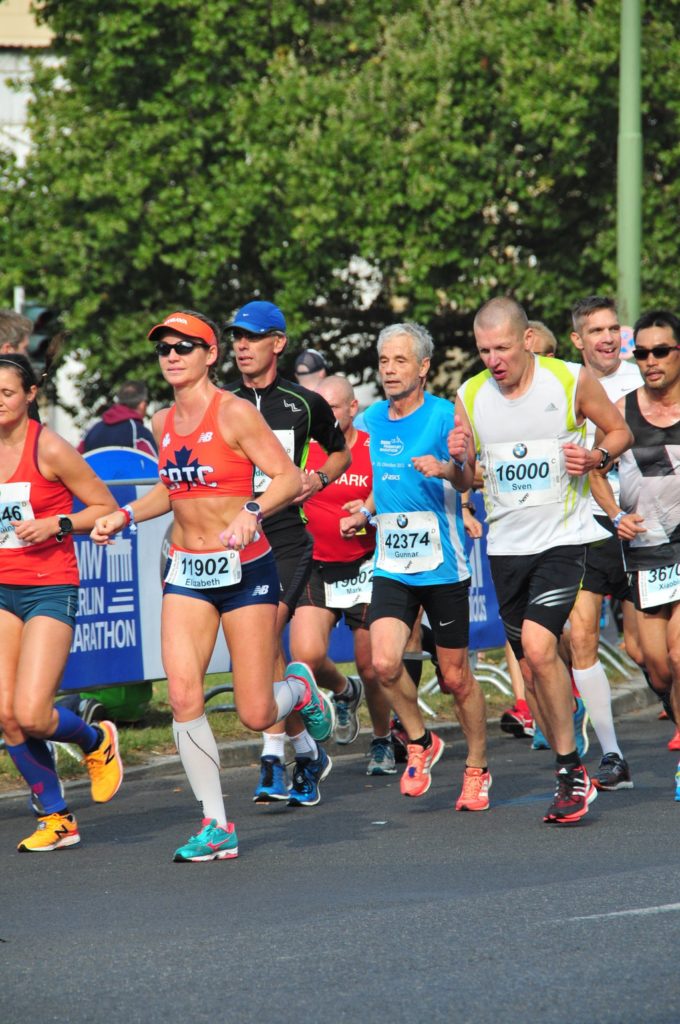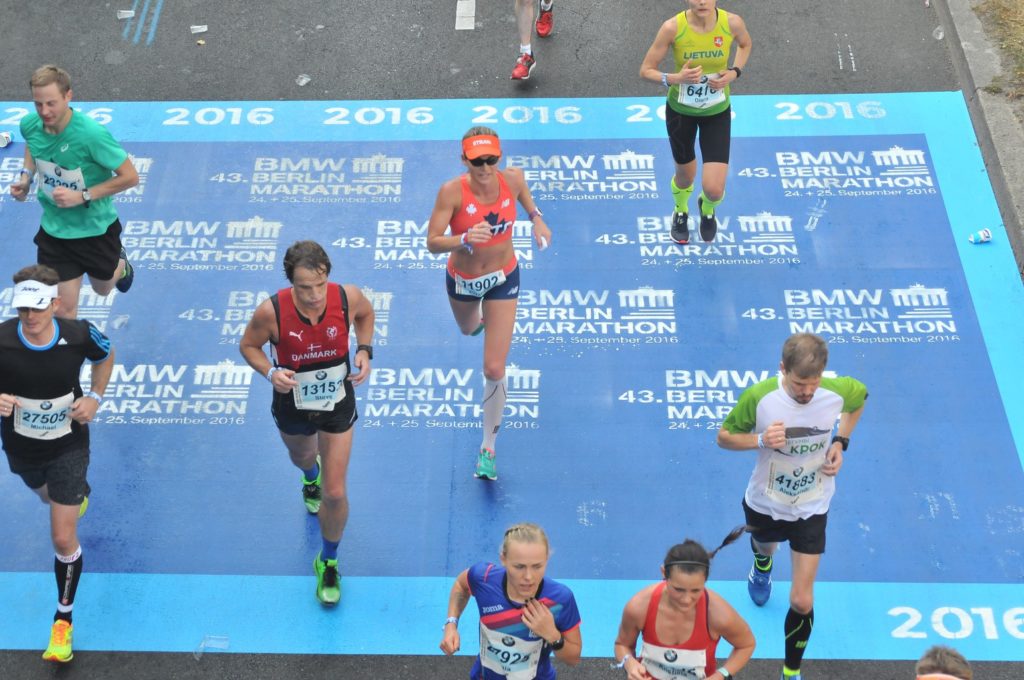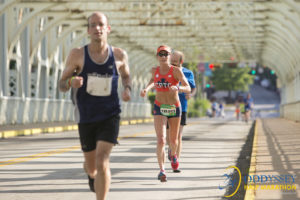
Early in the race. Feeling relaxed.
Berlin Marathon had been on my radar since I was notified I’d been selected via lottery back in December 2015. With a reputation for being the fastest marathon in the world, I knew if I went to Berlin, I’d go to race – not to simply run. This would mean training to race my first marathon since 2013. So over 10 months ago the goal was set: race Berlin 2016, aim to break 3 hours, or set a new PR.
The road to Berlin wasn’t easy. Some days or weeks would click into place. Others were a struggle, and filled with doubt. I questioned my decision to coach myself on more than one occasion. There’s a reason why many coaches hire someone else to coach them – it’s hard to be the student and the teacher. I questioned my potential. Was my 3:05:27 back in Philly 2013 as good as it gets? But doubts never lead to anything good. And I knew my training was smart. So I’d try to shake those doubts and focus on the good and great workouts. Just like bad weeks of training come and go, so do good ones. Neither one defines us. I am thankful to be surrounded by some incredibly supportive people. Friends, coworkers, team mates, family – people who understand or at least respect the grind. My roster of private athletes have cheered me on. And so when the going would get tough, I’d remember to lead by example and continue to grind away. By the time I got to Germany, I knew all I could do was trust my hard work and preparation, and have confidence in that.
I had never been to Berlin before. It’s a really beautiful city. I was oddly calm about marathon morning (I’m usually a basket case), and was actually capable of enjoying the city for a solid 36 hours before race day. The day before the race was spent walking at least 4 miles around the city, and a 3-mile shakeout run that evening. I ate pasta with a German beer, laid out my running gear, and that was it. Was I nervous? Sure. But I was also calm. I accepted that it was going to be 3 hours of work, and that I was ready.
The weather race morning was perfect. Cool and sunny, with no breeze. The marathon gods were good to us. As I stood in my corral, and the announcers counted down to the started, I began to cry. I was overcome with the power of the moment. The amazing park. The
40,000+ other athletes. The opportunity before me. I quickly collected myself, and within a few minutes I was across the starting line.
The course is fast. And there’s a blue tangent line on the course. I decided I’d stick to that line as though it were glue. This was the first marathon I’d ever run with no mile markers (only kilometers), and I was one of few athletes around me who’s watch would go off at the miles. I told myself to stay relaxed and efficient. I hydrated early and often. Around the 20K I saw Vinnie, and that was like a kick of energy. In an unfamiliar city, a familiar face was priceless. Around 17 miles into the race, I felt amazing. Pacing was good. I felt that a sub-3 was going to require a kickass final 10K, but a PR was mine to lose.

Eye is on that clock.
Then around 19-21 miles in, a few things happened. One, I began to cramp. Not runner cramps, but lady cramps. The kick in the uterus feeling, on my right side. In the beginning it was relatively dull, but as the miles went on that changed. I was incredibly mad at myself, as I had planned to take ibuprofen that morning (I’d had cramps off and on for a few days), but that morning had felt good and I opted to go it without precautionary meds. And then the nausea and gag reflex to GU began to happen. It was a burp that turned into a “Oh no, I just kinda threw up in my mouth” moment, and this was before I needed to take my final GU around 20 miles. I forced that final GU down, but it wanted to come back up. The final 5 miles were a painful negotiation. I debated stopping for a break and to try and regroup. I debated walking off if Vinnie were at the next turn. My body was struggling and my brain wasn’t giving me the ability to simply pick up the pace.
I told myself to do what I could. If I lost my PR, it wasn’t the end of the world. Just do your best. Just finish this. And so I continued. Paces slipped. I walked through a hydration station in the 23rd mile, hoping that brief pause in running would help the cramps. It made it worse. And so back to running I went. My eye on the clock, I took it one mile at a time. I saw Vinnie around 24 miles, and I mumbled something about this really hurting as I pointed to my side. He ran beside me for half a block, yelling encouraging things, to which I told him to shut up and stop lying. And so I continued.
The final 600M of the Berlin Marathon is spectacular. I think. I don’t really remember. The final stretch was lined with people. I focused on the clock. You can see the finish line a long ways before you get there. Glancing at my watch, I knew a PR was in the cards, but by how much – I wasn’t sure. Just finish this. Just get there. Just get this done. That’s all I could think about. Crossing the finish line I felt relieved, tired, emotional, and still in pain. The nausea was thankfully replaced with hunger by the time I got back to the hotel. And I took ibuprofen immediately to kick said cramps to the curb.
The rest of the day was filled with walking around, beer and food. I am in shock (and a little mad) at how good my legs felt after that marathon. There was so much more left in them to give. But they couldn’t have their day. My disappointment didn’t last long. How can it? I did the best I could that morning. And yes, I walked away with a PR. That PR, that much closer to 2:59:59 – it makes me that much more hungry for it and that much more confident it’s in me.
Here are the official stats:

Finish time: 3:03:30 (average pace: 6:58s)
100th female (11th American)
Splits:
Mile 1: 6:50, Mile 2: 6:51, Mile 3: 6:56, Mile 4 :6:58, Mile 5 : 6:51, Mile 6 :6:57, Mile 7: 6:49, Mile 8: 6:52, Mile 9: 6:53, Mile 10: 6:48, Mile 11: 6:51, Mile 12: 6:52, Mile 13: 6:49, Mile 14: 6:53, Mile 15: 6:54, Mile 16: 6:54, Mile 17: 6:57, Mile 18: 6:59, Mile 19: 6:55, Mile 20: 6:57, Mile 21: 7:07, Mile 22: 7:02, Mile 23: 7:13, Mile 24: 7:30, Mile 25: 7:12, Mile 26: 7:17, .34 miles: 2:13.
A few tips for future Berlin Marathoners:
- Stay at Hotel Adlon Kempinski. It’s worth the money. Not only is the hotel gorgeous, quiet and comfortable, but it’s literally at the Brandenburg Gate – a very short walk to the start/finish lines and on the marathon course.
- Make morning preparations the night before. It turned out the hotel had some food/coffee for marathoners in the lobby, but no coffee shops open before 8am (some 10am) on Sundays. I bought a bagel and coffee from Dunkin Donuts the night before.
- The expo was a mess. So go to it patient, and ready to get in/get out. I couldn’t have really shopped for anything if I had wanted to.
- Be sure to plan to use your own fuel. The drink and fuel choices (which included Red Bull) on the course were new to me. I stuck to water the the 4 GUs I brought.
- When planning your trip, account for jet lag. It’s not every day I run a marathon at 3am. Do everything you can to get on schedule before race morning.
- Go for your shakeout runs in the Tiergarten. That park is the most stunning thing ever.





